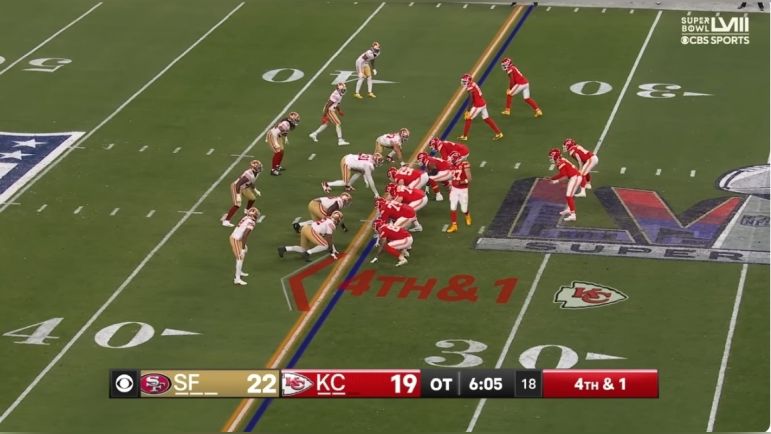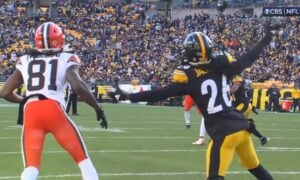There’s no getting around it. The Kansas City Chiefs have Patrick Mahomes. The Pittsburgh Steelers and the rest of the NFL do not. Which makes competing for any Super Bowl a difficult mountain to climb. Like Tom Brady, the best way to get past Mahomes is to avoid him. On the Steelers’ three Super Bowl trips during the Brady era, they never played the Patriots. And the same will be true for Mahomes and the Chiefs.
But Kansas City didn’t win Super Bowl 58 solely because of Mahomes. It’s a huge reason, no question, but there’s another layer. The Chiefs are capable of doing what’s obvious and seemingly simple but so hard for the rest of the NFL. Nail the play call in the “gotta have it” moments. Offense and defense. When the game is on the line, you have to come up with your best play. Kansas City does, and Mahomes goes out and executes.
Here are a few plays from the Super Bowl to show you what I mean.
Starting late in the fourth quarter. The game tied at 16, 49ers in (long) field goal range, facing third and four. With the two-minute warning over and the Chiefs left with two timeouts, if the 49ers convert, they can basically run the clock down to a handful of seconds left and line up for a game-winning kick. Kansas City must get a stop here. Has to happen.
Defensive Coordinator Steve Spagnuolo dials up the perfect call. The only time the Chiefs used a 7 DB package all game, CB Trent McDuffie blitzed off the right slot, a six-man pressure with blitzers from each side, putting the RB in conflict (the 49ers had enough blockers but the pressure created confusion and a missed pickup).
McDuffie rushes in the B-gap between the left tackle and left guard, the ROLB having a one-way go rushing wide to occupy the left tackle upfield while the ILB No. 32 rushes down into the B gap to take the eyes of the left guard. It creates a free lane for McDuffie, who pressures Purdy and times his jump to bat the throw down incomplete. No more time off the clock.
The 49ers convert the field goal, but the Chiefs have plenty of time for Mahomes to drive downfield.
And drive the Chiefs do. Still, with 16 seconds left, they’re looking at about a 50-yard kick. Facing 3rd and 7, a conversion here greatly increases the chances of Harrison Butker converting while still giving Kansas City a chance to put the ball in the end zone.
What do you do in these “must-have” moments? Get the ball to your best player. That means scheming TE Travis Kelce open. The Chiefs align 3×1 with Kelce as the backside “X,” a reduced split tight to the tackle. The 49ers don’t play it poorly, matching Kelce with their top LB, Fred Warner, but the offense still has the advantage.
Warner plays with outside leverage, and Kelce breaks across his face on an over/crossing route. A mesh look from the trips side, No. 3 to the top, coming on the crosser to try and slow up Warner but driving upfield to not interfere with him and get called for OPI. Kelce gains a step inside, and Mahomes hits him on the crosser, Kelce turning upfield and converting for big-time YAC, finishing the play with violence down to the 10. The Chiefs are in high-percentage field goal range and have the chance to find the end zone and win. They didn’t, but this play put them in a great position and was a massive third-down conversion.
Overtime. After the 49ers kicked a field goal on their opening possession, the Chiefs faced 4th and a half-yard on their 34. Get stopped here, and the game is over. What do you call? You go with your best call that gives your quarterback options, an answer to any “test” the defense might throw at you.
A run-pass-run option. Mahomes reads the playside defensive end on a give/keep read. If the end crashes down, keep the ball. If he takes the QB, give to the runner (I’m actually a little inclined to believe there really is no “give” option here given the back’s and the line’s body language, but the mesh point influences the RDE to step down).
From there, Mahomes can either hit TE Travis Kelce in the flat if it’s open or he can run the ball himself. The 49ers’ No. 33 takes Kelce to the flat, clearing a lane for Mahomes up the middle. He converts with ease, gaining five. The Super Bowl plays on.
A few plays later. The Chiefs in 3rd and 6. The Chiefs dial up a call similar to Kelce’s catch at the end of regulation. They go 3×1 with condensed splits. But here, the X receiver, WR Rashee Rice, to the bottom, runs the mesh instead of Kelce. He runs underneath the receiver from the trips side.
With the 49ers playing off/sticks coverage, there’s lots of space, and the 49ers DB on Rice goes over the mesh. It puts him in trail position, and Mahomes hits Rice in-stride, who jets upfield for the conversion and extra yardage. A nice “assist” from TE Travis Kelce here on a DB to get in the way, the type of things new OC Arthur Smith will demand from this group.
This completion alone puts Kansas City on the edge of field goal range.
Finally, the Super Bowl winner. Here, it’s first and 10 for the Chiefs. No panic, they know the rules and understood the game wouldn’t end at the end of this overtime period. It would go into double OT if the Chiefs didn’t win it. Still, they had the perfect play call. This year’s version of “Corndog” as Reid called it, with “extra ketchup and mustard.”
Return motion from WR Mecole Hardman, messing with the 49er’s eyes and out-leveraging them to the flat. The bunch and tight set create a free release and trash for the 49ers to wade through. Kelce isn’t even looking for the ball here. His goal is to just get in the way, and he watches the touchdown on the video board. He knows where the ball is going.
Touchdown. Super Bowl. Back-to-back champs.
The common theme of these plays isn’t that Patrick Mahomes or the Chiefs are doing anything superhuman. He’s not running around, breaking a bunch of would-be tackles, firing crazy off-platform throws, or launching 50-yard downfield attacks. He’s making smart decisions, he’s putting his team in good situations, but these are rhythm throws. This is taking what the defense is giving you, hitting the open receiver, and letting them do the rest.
Defensively, it’s a well-timed call to counter the 49ers’ plan and guys making plays.
This is what separates good from great teams. The 49ers have a loaded roster. There is tons of talent, offensively and defensively. And they had a great initial plan. They were the better team in the first 15-30 minutes. But when the game was on the line, the Chiefs had the right calls. This was flawless. They met every big moment with the right call.
Bringing it back to Pittsburgh, it’s an area they’ve struggled. Think about the Houston Texans game, Kenny Pickett injured on 4th and 1. The play call didn’t meet the moment, the Steelers going back to a call they made on 2nd and long earlier in the game. Of course, they’ve had some of these types of plays in short-yardage or key moments, but their issues were some situational football and finding ways to get the ball to their best guys, even in moments where the defense knows that’s where the ball is going. And they definitely haven’t done a good enough job of scheming players open.
Those will be the tasks of new OC Arthur Smith. Knowing Pittsburgh doesn’t have a Mahomes or elite-level quarterback on the roster who can just make everyone better, they have to win with scheme. The coaching has to elevate the players. And they need to copy this page of the Chiefs’ playbook, being able to make the right calls in critical moments to win games. It’s how KC won another Super Bowl.








